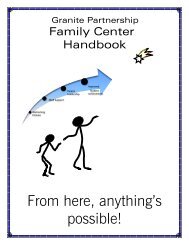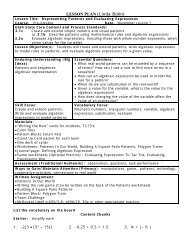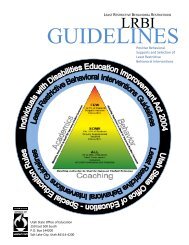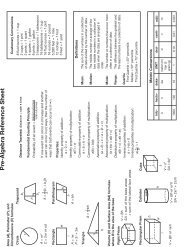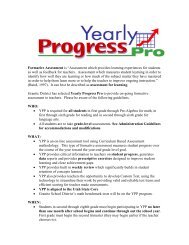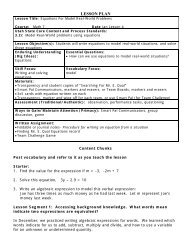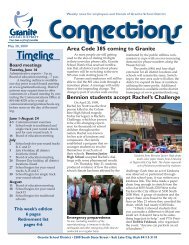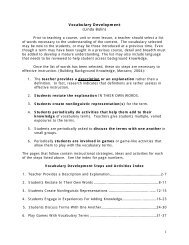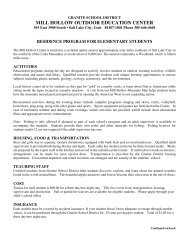LESSON PLAN (Linda Bolin) - Granite School District
LESSON PLAN (Linda Bolin) - Granite School District
LESSON PLAN (Linda Bolin) - Granite School District
Create successful ePaper yourself
Turn your PDF publications into a flip-book with our unique Google optimized e-Paper software.
Lesson Segment 1: How can proportions be used to solve percent problems?<br />
Do Stand-Up If, where the students stand for a statement if they believe it is true. Ask a few<br />
students to justify their choice to stand or not.<br />
1. Percent means a part out of 100.<br />
2. If we say 50% of our class prefers chocolate ice cream, this means 50 of us prefer chocolate ice<br />
cream.<br />
3. 50% of our class would be about 18 people.<br />
Q. So if 50% means 50 out of every 100, how can we know how many that is out of 36 (or<br />
whatever number of students is in the class)?<br />
To help students visualize the percent of a number, give student pairs a Percent Estimator and<br />
Smart Pal with Percent Estimator graphic to shade. Students work together to slide a covered card<br />
stock bar on the % side and on the part to total number side to see the ratios. They should also<br />
shade the Smart Pal for both % and part to total. Using the bar, they should try to determine about<br />
what fraction of the whole represents the percent given. Use:<br />
a) 25% of 20 b) 40% of 30 c) 10% of 50 d) 75% of 10<br />
After estimating using the Percent Estimator, have the students set up a proportion using<br />
part/total = %/100 as the ratios, and have them find the exact number.<br />
Q. What if we knew the part to total ratio, but didn’t know what percent that would be. How could<br />
we find a percent?<br />
Repeat the visualization with the Percent Estimator and Smart Pals. This time have them estimate<br />
about what the part to total ratio bar would look like and slide the bar up the % side to estimate<br />
the percent. Use:<br />
a) 30/40 is what %? b) 12/48 is what %? c) 10/25 is what % d) 1/12 is what %?<br />
Read parts of the book, “If The World Were A Village” by David Smith. Use the attached worksheet<br />
to find out how many people that would be in the classroom if the class were typical of the world.<br />
Lesson Segment 2: How can proportions be used to solve tax and interest<br />
problems?<br />
Use appropriate text problems involving tax and interest to practice setting up<br />
proportions to solve. Students will need to determine what the part represents, and<br />
what the total represents in the first ratio if you use:<br />
__Part__ = _%_<br />
Total 100<br />
If you are finding the total cost after tax is being paid, it is helpful for students to<br />
consider the part as original price plus tax, the total as original price, and the percent




